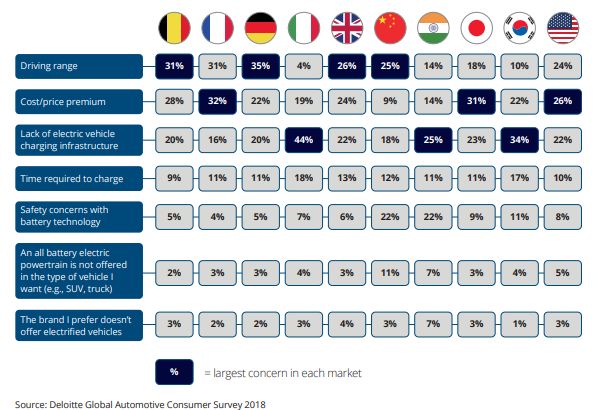Recent data released by King's College London has shown that there is a correlation between incidents of cardiac arrest/strokes and levels of air pollution.1 Simon Stevens, chief executive of NHS England, has said:
"... it's clear that the climate emergency is in fact also a health emergency. Since these avoidable deaths are happening now – not in 2025 or 2050 – together we need to act now."
The UK government has identified uptake of electric vehicles (EVs) as key to addressing these issues. The Treasury has launched a £400 million fund to help develop Britain's vehicle charging infrastructure, with the first £70 million allocated for 3,000 charge points – more than doubling the number across the UK to 5,000. A further £142.9 million was announced for Research and Development to combat air and water pollution.2
It is expected that sales of EVs will hit 7 million a year by 2025, making up 7% of total vehicle shipments.3 Battery electric vehicles (BEVs) currently make up 66% of the global EV market.4 Deloitte estimates that the market will reach a tipping point in 2022 – where the cost of ownership of BEVs will be on par with its internal combustion engine counterpart. With cost of ownership no longer a barrier to purchase, electric cars will become a realistic, viable option for any new buyer.5 However, there are a number of other barriers to overcome in the next few years if the market is to see this kind of growth.
Cost of EVs
Under EU rules, carmakers are required to decrease the average CO2 output of their fleet to 95 grams of CO2 per kilometre by January 20206. Missing the target results in a fine of €95 per gram over the target, multiplied by the number of cars sold in the EU.7 Subsequently, car manufacturers are trying to significantly increase sales of EVs to avoid EU fines.
EV technology is still relatively expensive. Attempts to develop and manufacture EVs in time for the 2020 deadline come at a significant cost to manufacturers, which are trying to balance their desire to avoid fines and price EVs competitively – to encourage consumer uptake – against these significant costs.
The relatively high costs of EVs mean deep-pocketed, established carmakers are at an advantage. For example, Dyson has cancelled its highly anticipated electric car project as it is not commercially viable for the company.8 Despite the Dyson group's expertise in battery systems and investment from the UK government, its overall lack of funding prevented it from competing with major carmakers that are able to sell BEVs at a loss.9
Contrastingly, established carmakers are introducing a host of new electric and hybrid vehicles to the market to meet the CO2 deadline and avoid negative publicity associated with punitive fines. For example, the CEO of VW expects to sell approximately 100,000 of VW's battery-driven ID3 model next year, alongside 60,000 equivalent vehicles from its wider brand, including the likes of Skoda and Porsche.10
However, it remains to be seen whether the production of new electric and hybrid vehicles will be met by sufficient market demand. Although sales of EVs are expected to increase over the coming years, consumer concerns will need to be addressed. Deloitte has reported that driving range and cost of ownership are significant concerns, as highlighted below:11

In order to encourage uptake, EVs must be a convenient and reliable option for consumers. The ACEA (the body that represents European carmakers) has said that this means everyone must have the ability to refuel or recharge their car easily, no matter where they are. Subsequently, the ACEA has called for a Europe-wide refuelling and charging infrastructure to help boost sales of EVs and ultimately meet CO2 targets.12
Challenges to infrastructure
The UK government has introduced regulations to reduce transport emissions and support the early market for ultra-low emission vehicles; it wants almost every car and van to be zero emissions by 2050. Examples of UK regulations encouraging the use of EVs include:13
- the Alternative Fuels Infrastructure Regulations 2017: requiring charging operators to comply with a common set of standards for socket outlets and vehicle connectors, and to meet requirements for intelligent metering;
- the Road to Zero Strategy 2018: setting out measures for reducing emissions from road transport, such as increasing charge points for EVs, including in new homes; and
- the Automated and Electric Vehicles Act 2018 (the AEV Act): requiring installation of charging points across motorway service areas and smart functionality of charging points.
Despite increasing legislation and government initiatives encouraging EV uptake, significant improvements are yet to be made to UK infrastructure. New league tables published by the government indicate that the UK currently lacks a widespread infrastructure network of charging points.14 Although the Department of Transport confirms that "there are now more charging locations than petrol stations"15, Scottish Power estimates that the UK requires 25 million charging points for EVs (which equals 4,000 new charging points a day) to help achieve its target of net zero carbon emissions by 2050.16
Recent developments
2019 has been a big year for technology in this space, with the Nobel Prize for Chemistry being awarded for rechargeable lithium-ion batteries.17 Because of this breakthrough, the lithium battery's potential has doubled, creating the right conditions for a vastly more powerful and useful battery. This breakthrough will have a huge impact on BEVs. Only last month it was announced that new technology could give BEVs more than 200 miles of charge in as little as 10 minutes. Rapid charging requires a high current. In order to allow the battery to cope with such a high current without damaging it, the battery needs to be at a higher temperature. Prolonged high temperatures cause other problems for the battery. However, a team at Pennsylvania State University has been utilising a thin layer of nickel foil to create an internal self-heating structure, which allows the battery to be heated for the period of charging and then rapidly cooled to avoid damage.18
In addition to advancements in technology, governments are continuing to push for developments in infrastructure to promote widespread use of EVs and ultimately reduce carbon emissions. For example, the UK government's recent consultation focused on proposals for regulations over EV charge point smart technology – the aim is to create a smart metering infrastructure that enables consumers to switch smart services providers and delivers high level end-to-end security.19
An Ofgem report20 considered different supply rules for charging EVs at home, on-street charging, destination charging (e.g. charging at a workplace or supermarket) and charging en route (e.g. at a motorway service station). Regulation 5 of the Alternative Fuels Infrastructure Regulations 2017 requires charging infrastructure operators to provide ad hoc access to charging points without pre-existing contracts or membership.21
The UK government is seeking to stimulate uptake of EVs by introducing green number plates for EVs. This initiative will enable local authorities to provide incentives for EV drivers, such as use of bus lanes or reduced parking fees.22
Closing remarks
It is clear that the three biggest barriers in the UK to uptake from a consumer perspective – driving range, cost premium and time to charge – are all currently on the agenda and some big technological advancements are being made in those areas. Consequently, we should see dramatic increases in consumer uptake as these issues find their resolution.
Although the cost to carmakers has resulted in it being difficult for challengers to enter the market, the regulations imposed by the EU are providing ample motivation for big traditional carmakers to develop and manufacture EVs. Manufacturers and service providers will, however, need to be mindful of the legal and regulatory environment to ensure that their products and services are aligned with recent developments in this space.
This article was co-authored by Deepali Sharma, a Trainee in the London office.
Footnotes
1. Click here↩
2. Click here↩
3. Click here↩
4. Click here↩
5. Click here↩
6. Regulation (EU) 2019/631 of the European Parliament and of the Council of 17 April 2019 setting CO2 emission performance standards for new passenger cars and for new light commercial vehicles, and repealing Regulations (EC) No 443/2009 and (EU) No 510/2011↩
7. Click here↩
8. Click here↩
9. Click here↩
10. Click here↩
11. Click here↩
12. Click here↩
13. Click here↩
14. Click here↩
15. Click here↩
16. Click here↩
17. Click here↩
18. Click here↩
19. Click here↩
20. Click here↩
21. Regulation 5, Alternative Fuels Infrastructure Regulations 2017/897↩
22. Click here↩
Dentons is the world's first polycentric global law firm. A top 20 firm on the Acritas 2015 Global Elite Brand Index, the Firm is committed to challenging the status quo in delivering consistent and uncompromising quality and value in new and inventive ways. Driven to provide clients a competitive edge, and connected to the communities where its clients want to do business, Dentons knows that understanding local cultures is crucial to successfully completing a deal, resolving a dispute or solving a business challenge. Now the world's largest law firm, Dentons' global team builds agile, tailored solutions to meet the local, national and global needs of private and public clients of any size in more than 125 locations serving 50-plus countries. www.dentons.com.
The content of this article is intended to provide a general guide to the subject matter. Specialist advice should be sought about your specific circumstances.


